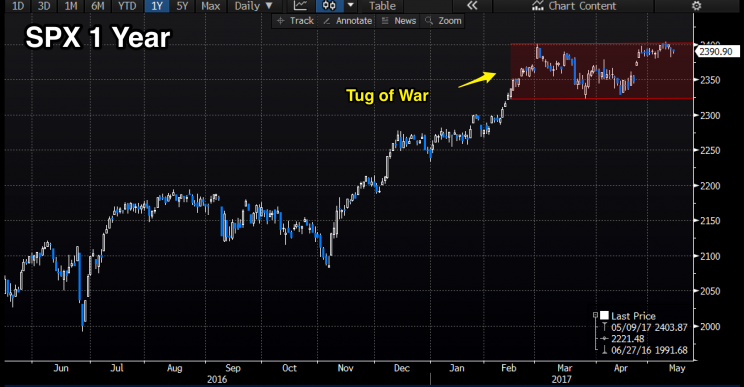Stock investors are caught in a tug of war between earnings and tax reform
Investors seem to have stumbled into the middle of a good old-fashioned tug of war. On one side, strong corporate earnings, sales and margins look to push stocks higher. On the other side is a paralyzed Washington, where both sides of the aisle believe the only thing that matters is “I win” and “You lose.”
The casualty is investor confidence with little impetus to drive shares higher. The realization that key parts of the administration’s economic agenda (i.e. tax reform) are at risk.

Investors may not care about health care or even the turmoil surrounding the Trump’s firing of FBI Director James Comey, but they do care about earnings. Some economists believe there could be as much as a $1 bump in S&P 500 (^GSPC, SPY) earnings per share for each percentage cut in the corporate tax rate—not to mention $2 trillion in corporate funds held hostage offshore. With strong bi-partisan support, repatriation could add hundreds of billions of dollars to a potential infrastructure spend.
As tax reform slips in the cue, so does the increase in earnings, making the valuation argument that much more real.

Given the backdrop, it’s easy to see why key aspects of the Trump Trade have stalled. Financials (XLF) are pretty much where they were after the election, and the developing bearish head and shoulders pattern speaks to the rising concern. If tax reform can slip, so can deregulation—and for that matter just about anything else in the agenda. I don’t want to get into the politics, but you can do the math.
Lost in all the noise is some good news
There is some good economic news, as the administration put together an important trade deal with China last week. American beef exporters have long sought access to mainland China, and any progress is certainly good news for those in the Midwest. The US will also be exporting LNG (liquefied natural gas). China is a huge importer of LNG, and the US is growing its export capability exponentially. All of this could pay dividends when negotiations with China turn to North Korea.
Why aren’t the markets down that much if people are worried?
In the absence of any clear direction, money flows to the new safe haven trades. In the old days, if you were concerned about growth, you turned to Proctor & Gamble (PG) or Campbell’s Soup (CPB) and maybe a drug stock or two.
Today you turn to Amazon (AMZN), Apple (AAPL), and Facebook (FB). These are the new consumer staple companies people can’t live without. More important than food and shelter, they also have the added benefit of having very large market caps and, in the case of Apple, the biggest. Meanwhile, underneath the surface, there’s been a rolling correction from one sector to the next.
The price action is eerily similar to the middle of 2015, when fewer and fewer stocks were participating. I went to the charts, and at least for now, they’re not alarming.

The percentage of stocks above their 200-day moving average is still healthy, but clearly heading in the wrong direction. The same can be said for the advance decline line.
All in all, US markets continue to digest conflicting information. Earnings and revenue growth look healthy, but valuations are hardly compelling—demanding some sort of positive catalyst to drive the next leg higher. Until we get it, the tug of war continues with investors stuck in the middle and, at least for the moment, unwilling to commit.
*At the time of this article some funds managed by David Nelson were long SPY.
————————————————-
Please contact your Belpointe investment advisor representative if there are any changes in your financial situation or investment objectives.
Investment advice is offered through Belpointe Asset Management, LLC. Past performance is no guarantee of future returns. Insurance products are offered through Belpointe Insurance, LLC and Belpointe Specialty Insurance, LLC. It is important to read our email disclosures available at this link: http://belpointe.com/disclosures.
